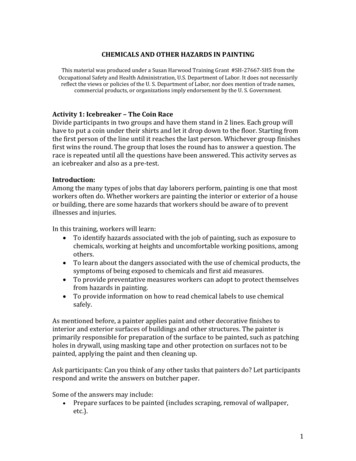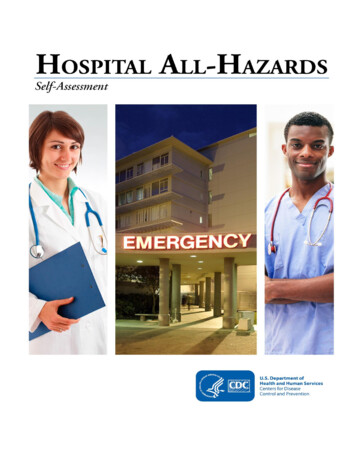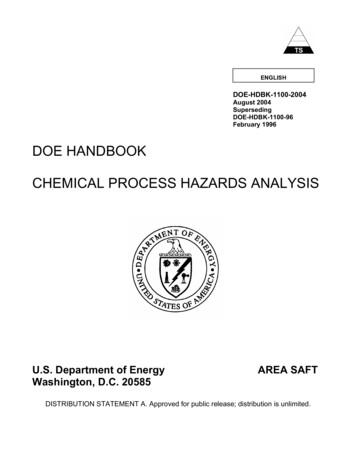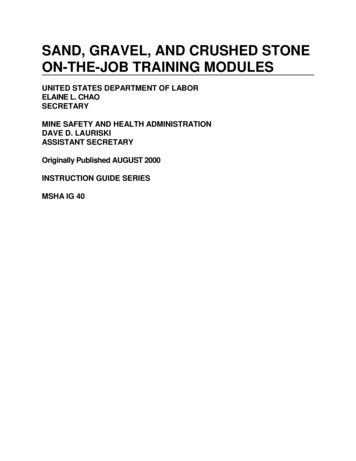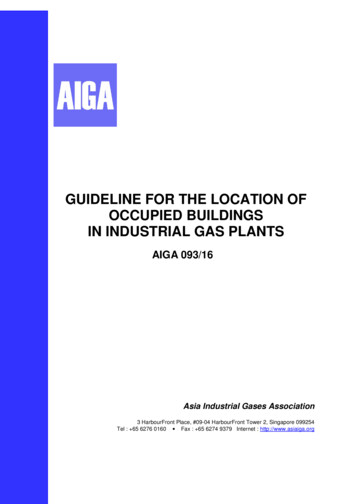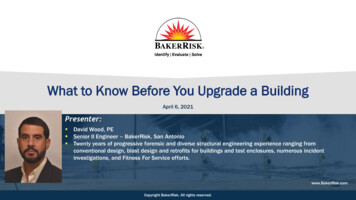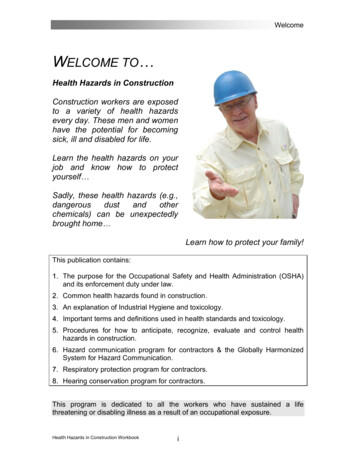
Transcription
WelcomeWELCOME TO Health Hazards in ConstructionConstruction workers are exposedto a variety of health hazardsevery day. These men and womenhave the potential for becomingsick, ill and disabled for life.Learn the health hazards on yourjob and know how to protectyourself Sadly, these health hazards (e.g.,dangerousdustandotherchemicals) can be unexpectedlybrought home Learn how to protect your family!This publication contains:1. The purpose for the Occupational Safety and Health Administration (OSHA)and its enforcement duty under law.2. Common health hazards found in construction.3. An explanation of Industrial Hygiene and toxicology.4. Important terms and definitions used in health standards and toxicology.5. Procedures for how to anticipate, recognize, evaluate and control healthhazards in construction.6. Hazard communication program for contractors & the Globally HarmonizedSystem for Hazard Communication.7. Respiratory protection program for contractors.8. Hearing conservation program for contractors.This program is dedicated to all the workers who have sustained a lifethreatening or disabling illness as a result of an occupational exposure.Health Hazards in Construction Workbooki
Acknowledgements & CreditsThis publication was produced by:Construction Safety Council4100 Madison StreetHillside, IL 60162(800) 552-7744www.buildsafe.orgCopyright 2012The Construction Safety Council will like to thank the following for their contributions andsupport: The Occupational Safety and Health Administration (OSHA) The National Institute for Occupational Safety and Health (NIOSH) The United States Environmental Protection Agency (EPA) Chicago Area Laborers – Employer Cooperation and Education Trust (LECET) United Union of Roofers, Waterproofers and Allied Workers elcoshimages.org LeBlanc Building Co., Inc. Milton R. Chicas David Allie (4-Safety.com) John Dimos, MS, CIHGENERAL DISCLAIMERThis material is intended for training purposes only. Its purpose is to inform employers and employees of best practices inconstruction safety & health. This material is not a substitute for any provision of the Occupational Safety and HealthAdministration (OSHA) or any standards issued by OSHA. If at any time it is discovered that the materials presented varyfrom Federal or State OSHA regulations, American National Standards Institute (ANSI), EPA regulations, state laws orlocal ordinances, it is understood that those regulations, laws and ordinances will take precedence over the materialspresented herein. In some cases, the information given may imply a higher level of protection then required in someFederal or State OSHA regulations. The mention of any products or materials by brand name in no way constitutesendorsement. Any products or materials not mentioned within this manual that may be considered acceptable asprotective devices, equipment, or practices is not intentional and should not rule out their acceptability as employee orenvironmental protection.OSHA DISCLAIMERThis material was produced under grant number SH-19495-09-60-F-17 from the Occupational Safety and HealthAdministration, U.S. Department of Labor. It does not necessarily reflect the views or policies of the U.S. Department ofLabor, nor does mention of trade names, commercial products, or organizations imply endorsement by the U.S.Government.Health Hazards in Construction Workbookii
Table of ContentsPageIntroduction to Industrial Hygiene1Anticipation of Health Hazards3Recognition of Health Hazards4Evaluation of Health Hazards7Control of Health Hazards12Job Hazard Analysis13Use of Professionals & Consultants15Introduction to OSHA17Workers’ Rights under OSHA Law20Health Standards in Construction – Overview23OSHA Permissible Exposure Limit (PEL)28ACGIH - Threshold Limit Value (TLV) 29NIOSH Recommended Exposure Limit (REL)30Hierarchy of Controls32Limitations & Use of Respirators43Respirator Types44Respirator Assigned Protection Factors45Respiratory Protection Decision Flow Chart46OSHA Emphasis Programs (Health Standards)47Competent Person & Training49Health Hazards in Construction – Overview59Health Effects and the Human Body61Acute Health Effects62Chronic Health Effects63Local Health Effects64Systemic Health Effects65Immediately Dangerous to Life & Health (IDLH)66Confined & Enclosed Spaces67Hazardous Atmospheres69Flammable & Explosive Hazards71National Fire Protection Association (NFPA 704M)75Globally Harmonized System of Classification & Labeling76Compressed Gas Cylinders82Toxic vs. Flammable Environments85Health Hazards in Construction Workbookiii
Table of ContentsPageOxygen Deficiency Hazards86Chemical Hazards in Construction88Chemical Hazards in Construction – Gases96Breathable Air98Simple Asphyxiants99Temporary Heating Devices & Asphyxiation102Chemical Asphyxiants103Welding, Cutting & Brazing Gases106Diesel Exhaust108Respiratory Protection for Exposure to Gases109Chemical Hazards in Construction – Vapors110Respiratory Protection for Exposure to Vapors113Solvents Commonly Used in Construction114Chemical Hazards in Construction – Fumes117Asphalt Fumes120Naphtha (Coal Tar)121Lead Fumes122Hexavalent Chromium123Respiratory Protection for Exposure to Fumes124Chemical Hazards in Construction – Dusts & Fibers125Crystalline Silica & Silicosis127Asbestos131Metal Dusts & Lead-Based Paint135Fiberglass Insulation136Respiratory Protection for Exposure to Dusts & Fibers137Chemical Hazards in Construction – Mists138Respiratory Protection for Exposure to Mists139Chemical Health Hazards Categories Summary Chart140Reproductive Toxins141Target Organ Effects142Synergistic Effect143Chemical Hazard Communication – Your Right to Know144Safety Data Sheet145Container Labeling Requirements147Health Hazards in Construction Workbookiv
Table of ContentsPageModel Hazard Communication Program149Physical Health Hazards in Construction157Temperature (Heat)158Temperature (Cold)161Occupational Noise164Hearing Conservation Program170Noise Reduction Rating (NRR) for Hearing Protectors171Noise Reduction Rating (NRR) Adjustment Calculation172Dual Hearing Protection173Repetitive Motion, Awkward Posture & Vibration174Pre-Work Stretch & Flex178Ionizing Radiation180Non-Ionizing Radiation183Biological Health Hazards in Construction189Fungi (Mold)190Histoplasmosis & Hantavirus192Respiratory Protection for Exposure to Fungi (Mold)193Bloodborne Pathogens194Poisonous Plants197Poisonous & Infectious Animals198Special Considerations for Construction201Chemical Glove Selection Chart203Respiratory Protection Program for Contractors207Respiratory Cleaning & Maintenance219Job Hazard Analysis Worksheet220Sample Confined Space Permit221OSHA Enforcement Policy – Respiratory Hazards Not Covered by OSHA22329 CFR 1926.55 Appendix A – ACGIH TLVs (1970)225Health Hazards Resources231Glossary232Health Hazards in Construction Workbookv
Course DescriptionOVERVIEWEmployers have the responsibility to protect the safety and health of theworker. This course will help prepare an employer or its designatedrepresentative (job-site competent person) to understand and react tooccupational health hazards in construction.Course participants will learn how to anticipate, recognize, evaluate and controloccupational health hazards; these hazards include, but are not limited to:chemical, physical, biological hazards. Special consideration will be given tooccupational noise exposure in construction.In addition, the participant will learn how and when to make managerialdecisions, such as how to implement a job-site hazard communicationprogram, how to select appropriate engineering & administrative controls andhow to properly implement a personal protective equipment (PPE) program.Also, participants will gain insight as to when to consult the expertise of anIndustrial Hygienist and/or other qualified person.The goal of this course (Health Hazards in Construction) is to enhancecommunication of health hazards between employers & employees, to preparean individual to make competent decisions on matters of occupational healthexposures in construction and to equip this person with the knowledge and skillsnecessary to perform frequent and regular inspections of the job-site. At theconclusion, each course participant will possess the confidence to recognize andavoid unsafe conditions and will be able to identify regulations applicable tohealth hazards in construction.INTENDED AUDIENCEThe target audience is the private sector construction employer, manager,employee or employee representative who, as part of a safety and healthprogram, would either be acting to fulfill the requirements of a competent person(to conduct frequent and regular inspections of a job-site) or performing safetyand health evaluations for their member employees and performing training asdescribed in OSHA’s construction safety & health standard 29 CFR 1926.Health Hazards in Construction Workbookvi
NotesHealth Hazards in Construction Workbookvii
PrefaceRESPONSIBILITY TO SELF & FAMILY!A worker’s exposure to hazardous materials on the job can be unknowinglybrought back to a person’s home; heavy metals such as lead dust, concretecrusted clothing and variety of oils, greases and solvents can all beunintentionally poisoning your family!As a worker who might be exposed to these hazards, you have a responsibility towear personal protective equipment (PPE), practice good hygiene and takeadvantage of training programs like this. Learn of the hazards associated withyour job and protect your family.Occupational health hazards can unexpectedly be brought home; wearpersonal protective equipment (PPE) on the job and do not bring homehealth hazards that can harm your family!Health Hazards in Construction Workbookviii
Introduction to Industrial HygieneINDUSTRIAL HYGIENELearning Goals:Important Terms: Define industrial hygiene. Industrial Hygiene Recognizeindustrialrelationship to OSHA. Identify andanalysisdefinehygiene’sjobhazard Be able to apply the classic industrialhygieneapproach(anticipate,recognize, evaluate & control) tohazard abatement.oAnticipate (hazards)oRecognize (hazards)oEvaluate (hazards)oControl (hazards) Toxicology Job Hazard Analysis Hazard AbatementIndustrial HygieneIndustrial hygiene is the art and science of anticipating, recognizing, evaluating, andcontrolling workplace conditions that may cause workers' injury or illness. Industrialhygienists use personal and environmental monitoring and analytical methods to detectthe extent of worker exposure and employ engineering, work practice controls, and othermethods to control potential health hazards.The History of Industrial Hygiene4th Century B.C.1st Century A.D.1556 A.D.1700 A.D.Hippocrates Noted lead toxicity inthe mining industry.Pliny the Elder Devised a face maskmade from an animalbladder.Georgius Agricola Publishes De Re Metallica diseases associated withmining occupations.Bernardo Ramazzini “Father of IndustrialMedicine” publishes DeMorbis Artificum Diatriba(The Diseases of Workmen).There has been an awareness of industrial hygiene since theancient times!Health Hazards in Construction Workbook1
Introduction to Industrial HygieneHealth Hazards in ConstructionChemical GasesVaporsFumesDustsFibersMistsPhysical Temperature Noise Repetitive Motion &Awkward Postures Ionizing & NonIonizing RadiationBiological Fungi (Mold) BloodbornePathogens Bacteria Poisonous Plants Poisonous &Infectious AnimalsToxicologyToxicology is the science that studies the poisonous or toxic properties of asubstance. The basic assumption of toxicology is that there is a relationshipamong the dose (amount), the concentration at the affected site, and theresulting effects. As part of your job as a construction worker, study and learn thehazardous effects of the substances that you work with; study the dangersassociated with the above health hazards in construction.Health Hazards in Construction Workbook2
Anticipation of Health HazardsAnticipation of Health HazardsHealth hazards can be anticipated by knowing thehistory of the work involved as well as throughworker experience and education; learn all thehazards associated with your job and be betterprepared to make good decisions regarding yourhealth and safety.Generally, hazards associated with a particular jobare either inherent (present before the worker showsup); or hazards can be created by the work (e.g.,welding & cutting, use of fuel powered equipment,etc.).To anticipate hazards: Survey job-site conditions. Be aware of the actions and behaviors ofworkers.What hazards can you anticipatein this picture?Old fuel storage tank beexcavated – site being preparedfor rebuild (fueling station).Hazardous conditions that can be anticipated on construction job-sites include: Confined or enclosed spaces (hazardous atmospheres). Contaminated soil conditions (hazardous atmospheres). Unsanitary conditions (poor housekeeping, poorly kept toilet facilities, etc.). Presence of hazardous materials (dangerous coatings on structures & metal containingalloys, concrete & silica). The use of hazardous chemicals (gases, solvents & glues). The presence of residues left by degreasing agents, usually chlorinated hydrocarbons(chloroform and carbon tetrachloride). Older buildings and structures; unoccupied dwellings (fungi/mold, asbestos & lead). Extreme temperatures (hot & cold environments; working outside or in attics, boiler rooms,etc.). Radiological exposures (nuclear power plants, antennas, hospitals, laboratories and the sun). Loud noise (use of tools and equipment). Hot work (welding and cutting). The presence of plant and/or animal wildlife (poisonous venom, feces, rabies ).Group Discussion What health hazards can you anticipate on your job?Health Hazards in Construction Workbook3
Recognition of Health HazardsRecognition of Health HazardsWhat do you see? Visible material in the air – If you see visibleclouds of vapor or particles, there may be a seriousexposure problem. Remember, however, that mostgases and vapors are invisible, and that often themost dangerous particles are too small to see. Settled dust – If there is chemical dust on theground or other surfaces, it probably got there bysettling out of the air. If disturbed, settled dust canbecome airborne again. Warning signs, labels & decals – As required byOSHA’s Hazard Communication Standard (29 CFR1910.1200) and other applicable standards.Concrete cutting with saw createsobvious dust exposure.Group Discussion What health hazards do you see on your job?Do you smell or taste anything? Odor – If you smell a chemical, you are inhaling it. However,some chemicals can be smelled at levels well below thosethat are harmful. The odor threshold is the lowest level of achemical that can be smelled by most people. If a chemical’sodor threshold is lower than the amount that is hazardous, thechemical is said to have good warning properties. It isimportant to remember that for most chemicals, the odorthresholds vary widely from person to person. In addition,some chemicals, like hydrogen sulfide, cause you to rapidlylose your ability to smell them; this is called olfactory fatigue.With these cautions in mind, knowing a chemical’s odorthreshold may serve as a rough guide to your exposure level. Taste – Never taste something that might be a hazardouschemical. However, if you inhale a chemical or accidentallyget some in your mouth, it may have a particular taste thatwarns you’re being exposed (e.g., metal fumes).Group Discussion What health hazards do you smell on your job?Health Hazards in Construction Workbook4Smell or taste couldcause you to recognizea health hazard.
Recognition of Health HazardsRecognition of Health HazardsDo you hear anything?Loud noise can severely damage your hearing!Sources of loud noise in construction: Hand tools (e.g., metal hammers) Power tools (e.g., jackhammers, grinders,saws, powder actuated tools) Equipment(e.g.,cranes, trucks)generators,excavators, BlastingGroup Discussion What sources of loud noise are on your job?Do you feel immediate symptoms? Particles in you respiratory system – Your noseand airways have mucous which traps particles andremoves them when you cough or blow your nose. Narcotic effect – When solvents are breathed in,they enter the blood stream and travel to otherparts of the body, particularly the nervous enness”, and tiredness. One result of thesesymptoms may be poor coordination which cancontribute to falls and other accidents.Feeling sick, dizzy or nauseouscould mean you are beingexposed to a health hazard.Group Discussion Have you ever felt sick or nauseous on the job (resulting from an on the jobexposure)?Health Hazards in Construction Workbook5
Recognition of Health HazardsRecognition of Health HazardsNot following safety procedures?Learn to recognize unsafe conditions and unsafe behaviors Not implementing engineering and/or administrative controls (e.g., wetmethods, ventilation, and dust collection systems). Not wearing appropriate Personal Protective Equipment (e.g., gloves,respirators, chemical suites, hearing protectors, etc.). Not practicing good housekeeping. Not following good hygiene practices. Not performing a hazard analysis (e.g., air monitoring, dust sampling, noisemetering, and biological monitoring & medical surveillance).Know the safety procedures on your job and learn to recognizesafety violations – report them and get them corrected!Never eat, drink, smoke or apply cosmetics in the areas where hazardous work isperformed; employers must train their employees on how to recognize and avoidunsafe conditions and unsafe behaviors!Health Hazards in Construction Workbook6
Evaluation of Health HazardsEvaluation of Health HazardsEnvironmental & Personal Air MonitoringEnvironmental and personal air monitoring is one way to determine exposure to mostchemicals. There are instruments to measure contaminates in the air – chemicalhazards, such as hazardous gases, vapors, fumes, dust/fibers & mists; also physicalhazards, such as noise, heat stress and radiation.Environmental & Personal Air Monitoring:NIOSH/John Rekus/elcoshimages.org Air monitoring does not measure you orwhat you are doing, but rather what youare exposed to on the job. Air monitoring must be done by a trainedhealth professional (industrial hygienist ortechnician). Monitoring can be done by measuring theair in a fixed location in the work area(area monitoring) or by placing themonitoring equipment on individualworkers and measuring the amount theyare exposed to (personal monitoring).Trained health professional wearingpersonal protective equipment;evaluating job-site conditions.Personal MonitoringPersonal monitoring is done to determine individual worker exposure and area monitoring may bedone to estimate possible exposure of a group of workers in a particular area. Monitoring isusually done during a specific time period, often as an 8-hour shift or 15 minute period to ensurecompliance with OSHA standards.Air monitoring may be done in a number of ways. Sometoxins are measured by placing a small pump on your beltand a filter cassette or tube clipped on your collar with aflexible tube running between them. The filter or tubeshould be located as close as possible to your breathingzone (the air in front of your nose and mouth which youbreathe).The pump pulls air through the filter or tube, which trapsthe dust or toxin. After the sample has been taken, thefilter or tube is sent to a laboratory. The laboratory usesscientific methods to measure the amount of contaminanton the filter or tube. It may take several days or longerbefore the results are ready from the laboratory.Health Hazards in Construction Workbook7
Evaluation of Health HazardsEvaluation of Health HazardsBiological Monitoring & Medical SurveillanceFor chemicals that are absorbed by routes other than inhalation, such as through theskin and by ingestion, air monitoring may underestimate the amount of chemicalabsorbed into the body; to ensure accurate employee exposure, medical surveillance issometimes necessary. The levels of the chemical (or its breakdown products) in thebody can also be measured in the blood, urine, or exhaled air. Such testing is calledbiological monitoring. For several substances, biological monitoring is required by lawwhen air monitoring results are above a certain level; employers must maintain theresults of these tests as employee records.Medical surveillance records include: Employee exposure records (results from personal air monitoring). Employee medical records (results from biological monitoring).Employee Exposure and Medical RecordsWorkers with possible exposure to or uses toxic substances or harmful physical agentson job-sites have rights to access exposure records. These rights and responsibilitiescan be found in OSHA’s standard 29 CFR 1926.33 (see 29 CFR 1910.1020 – Access toEmployee Exposure and Medical Records).Retention of Medical Records Employee medical records must beretained for at least the duration of theemployee’s employment plus 30 years. Employee exposure records for at least30 years (personal air monitoringresults). Backgrounddatarelatedtoenvironmental, or workplace, monitoringor measuring—such as laboratoryreports and worksheets—must only beretained for 1 year, so long as youpreserve certain interpretive documentsrelevant to the interpretation of the datafor 30 years.Health Hazards in Construction Workbook8Employee exposure and medical recordsmust be retained by the employer.
Evaluation of Health HazardsEnvironmental & Personal Air Monitoring DevicesHazardGases & VaporsDeviceDetector TubesExamples:oooooDescriptionDetects different gases and vapors; often used as a surveytool to determine if a substance is present or not – does notdetermine exact quantity or employee exposure.Easy to use and gives instant color change results; useseither a hand or a battery operated pump.Carbon MonoxideHydrogen SulfideMethaneAmmoniaChlorineOften non-specific and has a high standard of error ( 25%).Low cost.Sampling TubesEasy to use and can sample for more than one chemical on asingle tube.Tubes must be specific for type of gas or vapor.Not real time measurement – delay in results.Highly accurate in determining exposure.Low cost.Multi or singlegas/vapor detectorReal time measurement device that provides instant results;can be used as personal alarm monitors.Detects a variety of toxic gases and explosive environments.Easy to use, but requires calibration to be accurate; requireson-going maintenance.Sensors wear out (need replacement).Moderate to high cost.Passive badgegas/vapor samplerDevice worn to passively measure exposure.Simple to use; just put it on and go to work.Accurate device, but limited to the number of chemicalsmeasured.Not real time measurement – delay in results.Low cost.Fumes, Dusts,Mists & FibersInstant Swab WipesDoes not give detail as to amount, only if substance ispresent.Examples:ooooDetects the presence of lead in paint or metals.May show false positive results; perform second wipe toconfirm.LeadSilicaAsbestosPaintsLow cost.Filter CassetteUsed to determine an average exposure over a period of time(time weighted average).Samples taken in the “breathing zone” of the employee.Not real time measurement – delay in results.Specific filters required for different substances.Moderate cost.Health Hazards in Construction Workbook9
Evaluation of Health HazardsEnvironmental & Personal Air Monitoring DevicesHazardNoiseoDeviceSound Level MeterDecibels (dB)DescriptionMeasures ambient noise levels and is used as a surveyinginstrument; provides real time instant reading.Easy to use.Accurate device.Calibration required.Varies in cost.Personal DosimeterMeasures personal exposures to noise and determinesexposure over a period of time (time weighted average).Requires training to use.Accurate device.Calibration required.High cost.Noise badgeIndicates that user is being exposed to high levels of noise.Simple to use.No calibration required.Real time instant reading; used as a personal alarm.Low cost.RadiationooIonizingNon-ionizingFilm BadgeDosimetersMeasures personal exposure to ionizing radiation.Simple to use.Passive reading.Not real time measurement – delay in results.Low cost.Survey InstrumentsSurvey instrument to determine levels of ionizing radiation.(Geiger Counter)Easy to use.Real time measurement.High cost.Personal AlarmMonitors (RF)Measures personal exposures and provides instant results;used as a personal alarm.Specific to type of radiation.Easy to use.Moderate to high cost.Health Hazards in Construction Workbook10
Evaluation of Health HazardsEnvironmental & Personal Air Monitoring tionMeasures air temperature.Simple to use.Heat/HumidityCold/WindAccurate device.Survey instrument.Real time measurement.Varies in cost.Wet Bulb GlobeTemperature(WBGT)Estimates the effect of temperature, humidity, and solarradiation.Requires training to use.Accurate device.Calibration required.Measures personal exposures.High cost.ThermoAnemometerA measure wind speed and calculates wind chill temperature.Simple to use.No calibration required.Real time instant reading.Moderate to high cost.Wet Bulb Globe Temperature (WBGT)The Wet Bulb Globe Temperature (WBGT) is acomposite temperature used to estimate the effect oftemperature, humidity, and solar radiation on humans.Portable heat stress meters or monitors are used tomeasure heat conditions. These instruments cancalculate both the indoor and outdoor WBGT index.With this information and information on the type ofwork being performed, heat stress meters candetermine how long a person can safely work orremain in a particular hot environment.Health Hazards in Construction Workbook11Quest TechnologiesWet Bulb Globe Temperature(WBGT) Device
Control of Health HazardsControl of Health HazardsHazard AbatementRespirator – PersonalProtective Equipment(PPE)To abate a hazard means to eliminateits affects; this would cause a workerwho might otherwise be exposed to ahazard not be exposed by means of oneor more control strategy. These controlstrategies are chosen by preferenceaccording to the hierarchy of controls.Local exhaustsystem (vacuum)– EngineeringControlImplementing control strategies, such asengineering controls, safe work practicesand wearing personal protective equipmentwill stop health hazards on your job!Hierarchy of Controls(See Hierarchy of Controls, page 32)Controlling exposures to occupational hazards is the fundamental method ofprotecting workers. Traditionally, a hierarchy of controls has been used as ameans of determining how to implement feasible and effective controls.OSHA requires that employers use the hierarchy of controls inorder of preference for protecting the worker.Hierarchy of controls in order of preference:1. Elimination of hazard; Substitution with safe alternative.2. Engineering; Ventilation & wet methods.3. Administrative; Work practices, scheduling workers to minimizeexposure, extended breaks, etc.4. Personal Protective Equipment (PPE); Respiratory and hearingprotection, protection of face, hand, feet, eyes & whole body.Health Hazards in Construction Workbook12
Job Hazard AnalysisJob Hazard AnalysisA job hazard analysis (JHA) is a technique that focuses on the relationship between theworker, the task, the tools, and the work environment; it’s an essential first step thathelps an industrial hygienist determine the sources of potential problems.During a job hazard analysis, a competent industrial hygienist will examine allmaterials & equipment being used; look at the process in which work is beingperformed and assess the people performing the work.Questions that are asked during a job hazard analysis are What is it?Materials & Equipment – Whatbuilding materials, chemicals, tools andequipment are being used; what is thelikelihood that these things will cause apotential health hazard (gases, vapors,fumes, dusts/fibers, noise, vibration,radiation, etc.)?How does it?Process – How & where is the workbeing performed; potential healthhazards can turn into toxic exposures ifthe process is not controlled.Who are exposed?People – Who are exposed to thehazards; are these workers onalprotectiveequipment (PPE)?Health Hazards in Construction Workbook13
Job Hazard AnalysisJob Hazard Analysis ExampleLook at the pictures and complete the analysis Job/Task:What are the hazards?How & who are exposed?What controls are being implemented?What (if any) further controls need to be implemented?The Value of a Job Hazard AnalysisSupervisors can use the findings of a job hazard analysis to eliminate and preventhazards in their workplaces. This is likely to result in fewer worker injuries and illnesses;safer, more effective work methods; reduced workers’ compensation costs; andincreased worker productivity.The analysis also can be a valuable tool for training new employees in the stepsrequired to perform their jobs safely.Determining whether a health hazard exists at your worksite is based on a combinationof factors including observation, interviews, and measurements of the level of aircontaminants arising from the work processes as well as an evaluation of theeffectiveness of control measures in the workplace. These environmental measurementsare then compared to acceptable exposure levels, such as OSHA standards or otherguidelines.Health Hazards in Construction Workbook14
Use of Professionals & ConsultantsUse of Professionals & ConsultantsIf the work involves many different or complex processes, a professional may beneeded to help conduct job-site evaluation and personal exposure monitoring.Sources of help include insurance companies, contractor associations, tradeunions, and private consultants with safety and health expertise.OSHA offers assistanc
Health Hazards in Construction Workbook i WELCOME TO Health Hazards in Construction Construction workers are exposed to a variety of health hazards every day. These men and women have the potential for becoming sick, ill and disabled


